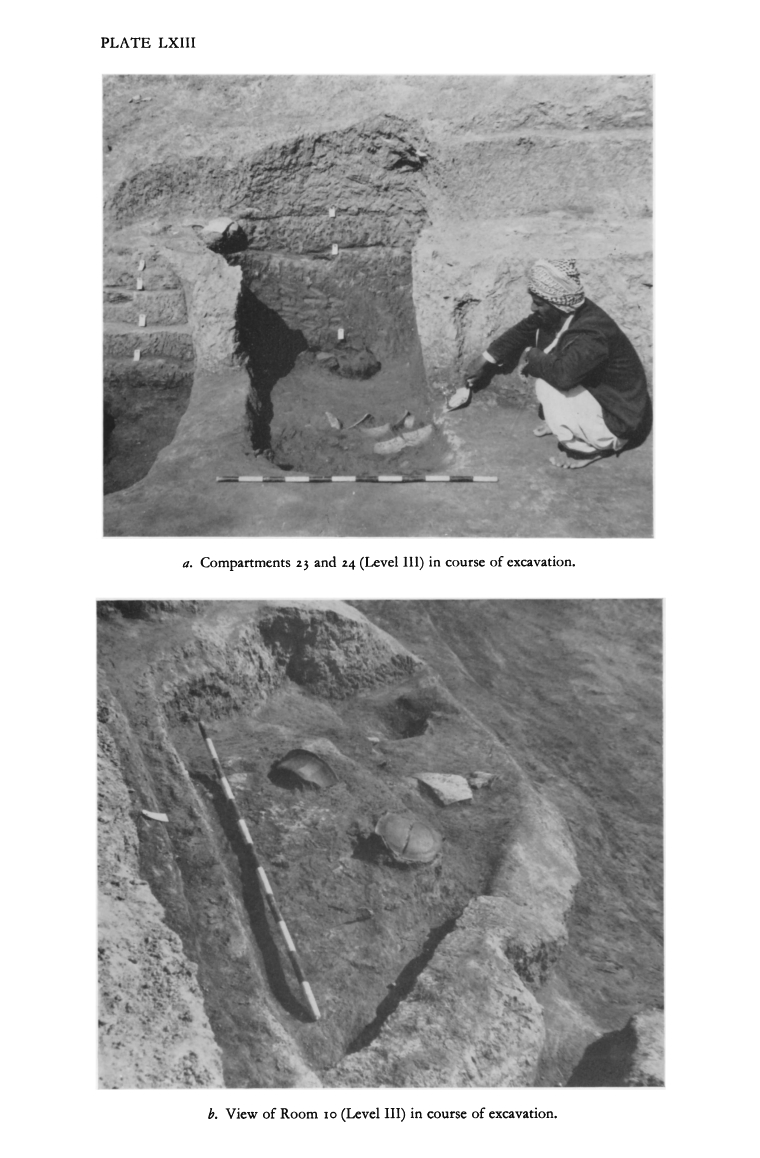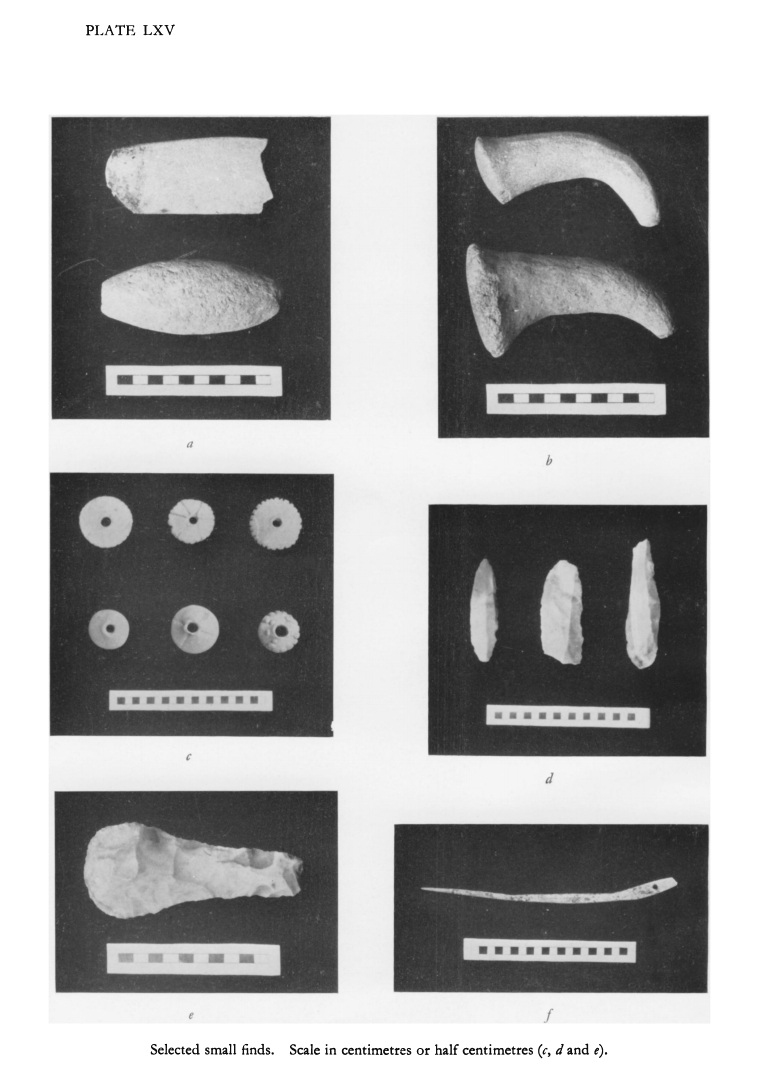|
Other Archaeological Sites / The Neolithic of the Levant (500 Page Book Online) Ancient Ras Amiya
Excavations at Ras al Amiya by David B. Stronach INTRODUCTION: The prehistoric site of Ras al Amiya is situated about five miles north of Kish at a point midway between the rivers Tigris and Euphrates. The whole settlement lies under the present surface of the alluvium and it only came to light some four years ago when a series of canals were cut through the area in connection with the Greater Musseyib Drainage Project. Attention was first drawn to the site when it was discovered that sherds of the richly painted Hajji Muhammad variety were associated with others of a more standard Ubaid type. The association of the two wares at once suggested that the settlement might have an important bearing on certain problems connected with the evolution of Ubaid pottery and that excavations might produce useful results. At the same time the impending use of the canals in the area seemed to call for an early start to any such field work. With these considerations in view the British School of Archaeology in Iraq decided to support a small sounding at the site in the early summer of last year. Significant Results of the Excavation: The special importance of Ras al Amiya stems from the fact that it documents the transition from the comparatively closely painted pottery of the Haiji Muhammad phase to the more sparsely decorated material of later Ubaid times. For although the broad range of Hajji Muhammad shapes and patterns was recovered from the German excavations at the type site of Qal’at Hajji Muhammad near Warka some twenty-five years ago, and the later excavations at Eridu revealed the precise stratigraphic position of such pottery between the older Eridu ceramic on the one hand and the later Ubaid one on the other, the exact relationship of these various wares has always remained in doubt. In this connection the Ras al Amiya material has helped to bridge the gap between the Hajji Muhammad and subsequent Ubaid phases and it has drawn attention to the essentially unified character of the whole pre-Uruk sequence. As a recent analysis of the Eridu pottery has shown there is no evidence of breaks in its sequence and the excavations at Ras al Amiya may be said to fortify the view that is presently gaining ground that the Eridu, Hajji Muhammad and two later Ubaid phases were all part of a single developing ceramic tradition.
As indicated above the most obvious trend in this development is the gradual disappearance of many of the ‘ close-style ’ patterns that characterize the two earlier phases together with certain other changes in the quality of the
paint and the shape of vessels. Such criteria as these allow us to place the date of the Ras al Amiya settlement somewhat after that of Qal’at Hajii Muhammad as well as helping to define certain detailed distinctions between
Hajji Muhammad and later Ubaid pottery. But at the same time the varied material from the present site emphasises the importance of considering all the available evidence in dating a settlement of this transitional type; for in a
situation where simple curvilinear patterns date back to much earlier times and intricate ‘ close-style ’ patterns persist on certain shapes for a considerably longer period isolated objects may often prove misleading.
Our first examination of the site showed that the buried settlement lay across the path of two modern canals at a point 300 yards west of the main Musseyib Pumping Station (MAP). From the sides of the canals it was apparent that very heavy deposits of alluvial sand and clay lay on top of the original settlement and it became our first task to see if the original summit of the mound still approached the surface at any point. Unfortunately our exploratory shafts, which were sunk at a series of points through the alluvial cover, soon showed that the original centre of the settlement was never less than 1 metre 20 centimetres below the present surface of the ground while the edges of the settlement dropped away to a depth of at least 2 metres. With the limited time and resources at our disposal it was obviously impossible to move much of this overburden and we decided to take what advantage we could of the small and as yet dry Side Canal running through the eastern half of the site (Plate LX a Below). The Irrigation Authorities were most generous in allowing us to carry out limited excavations in the sides of this canal for a distance of over 100 metres and in one place we were permitted to make a vertical cut in the side of the canal to check our findings elsewhere. As a result of these soundings we found that we were dealing with an oval-shaped settlement covering an area of some 7 acres. At the same time it emerged that the summit of the mound must have lain well to the north somewhere to the west of the vertical cut in the Side Canal.
Flint: The variety of flint tools from Ras al Amiya is relatively small and the industry as a whole seems to have concentrated on the production of flint blades. Much the commonest form of blade is the long narrow type. Many of these appear to have been retouched on at least one edge and a fair number attest a fully serrated edge with a silicacious shine. In at least three cases the blades themselves still possess traces of bitumen. Thus there would seem to be little doubt that all such blades were mounted in wooden sickles of the type known from Hassuna and elsewhere. The only large flint object is the roughly chipped hoe which belongs to a particularly long-lived type. Since all the flint share the same light to dark honey-colour it would seem to have come from some common source, possibly located in the Zagros Mountains ... Conclusion: In a number of ways the evidence from Ras al Amiya has helped to fill out the picture of early prehistoric development in Mesopotamia. To begin with the lack of any Hajji Muhammad or earlier material from the wide area between Nippur in the south and Samarra in the north has long remained an archaeological puzzle. This gap has inevitably given rise to speculation as to the northern limits of both Haiji Muhammad and Eridu pottery and at the same time it has been difficult to tie down the exact relationship between these early southern wares and their counterparts further north. Only now that Hajji Muhammad pottery has been found as far north as Ras al Amiya can a fresh approach be made to certain of these problems. In the first place the new material from Ras al Amiya would seem to provide several useful indications of the northern limits of these wares. With regard to the Hajji Muhammad phase it is evident that despite the presence of certain Halaf shapes and designs the local Ras al Amiya pottery of Hajji Muhammad type is still not very different from that found at Hajji Muhammad sites in the extreme south. Therefore unless the penetration of Hajji Muhammad pottery into Halaf provinces was much more sudden than one would expect from contemporary cultures the northern limits of the Hajji Muhammad area would seem to have lain well to the north of Ras al Amiya. Equally if we turn to the probable limits of the earlier Eridu Ware the extensive northern distribution of Hajji Muhammad pottery would seem to argue for a wide extension of Eridu pottery in the same direction. Thus for the first time the stylistic resemblances that have been noted between the Eridu and Samarra schools of pottery would seem to be supported by a narrowing physical gap between the boundaries of the two wares. In quite another sphere one of the main contributions of Ras al Amiya has been to provide a fresh picture of the normal type of small village that must have existed throughout the southern half of Mesopotamia from at least the beginning of the Eridu phase down to early Ubaid times. The village at once presents a valuable contrast to the well built mud brick settlement that came into being in the later Ubaid levels at Uqair as well as a reminder that more formal architecture of the type exhibited by the temples at Eridu was still an exception in earlier periods. Possibly the closest southern parallels to the site are to be found in the ‘Hut Sounding’ at Eridu where the houses were even more flimsily built and at Hajji Muhammad where as far as one can see the whole settlement was a very similar one-period affair.
Other significant results lie in the field of animal domestication. The animal bones from Ras al Amiya may have produced the earliest skeletal evidence yet found for both domesticated cattle and sheep. Goat and pig also seem to have been represented at the site. But on two other counts our findings were less complete for not only were we unable to find any ancient grain samples but we were also unable to find any carbonized material for dating purposes. This last omission was particularly unfortunate for just at this stage of prehistoric research when an absolute chronological framework for the first painted pottery cultures of the Near East is beginning to emerge, an absolute date from a sealed site like Ras al Amiya might have been a considerable contribution in itself! ...
|

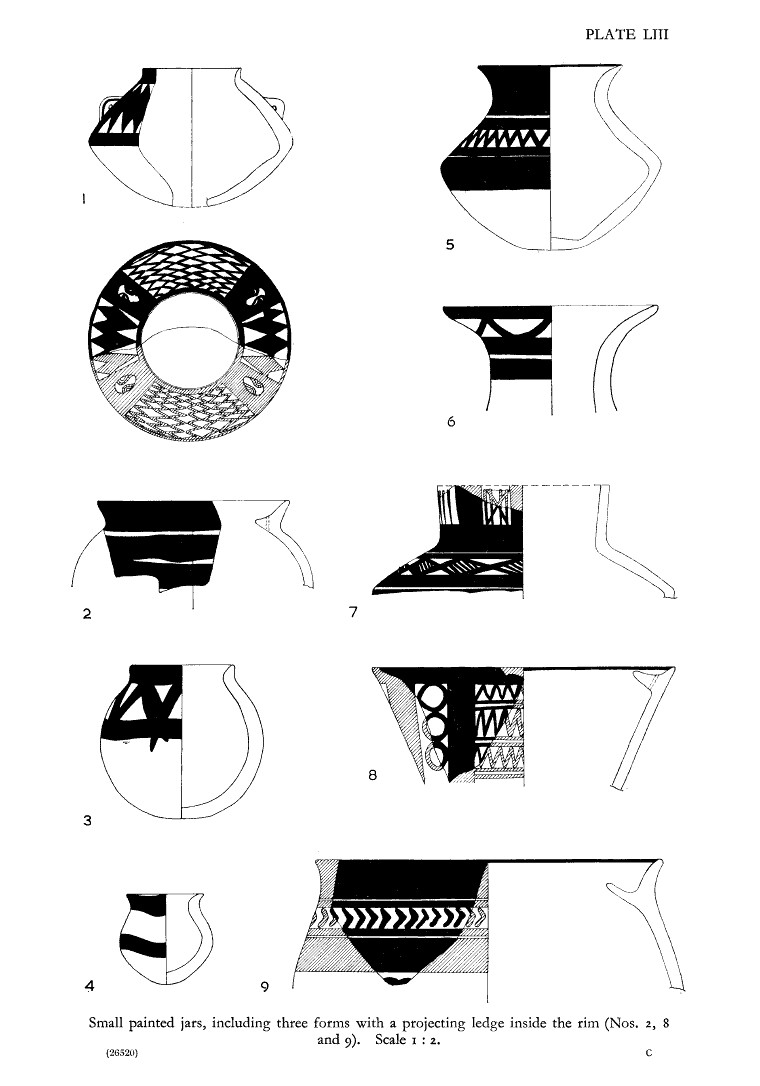 Situation of the Site: The area surrounding Ras al Amiya appears to have been one of the most popular regions for early settlement in Central Iraq. The region abounds in famous archaeological sites from the sprawling remains of Kish immediately to the south to the smaller mounds of
Situation of the Site: The area surrounding Ras al Amiya appears to have been one of the most popular regions for early settlement in Central Iraq. The region abounds in famous archaeological sites from the sprawling remains of Kish immediately to the south to the smaller mounds of 
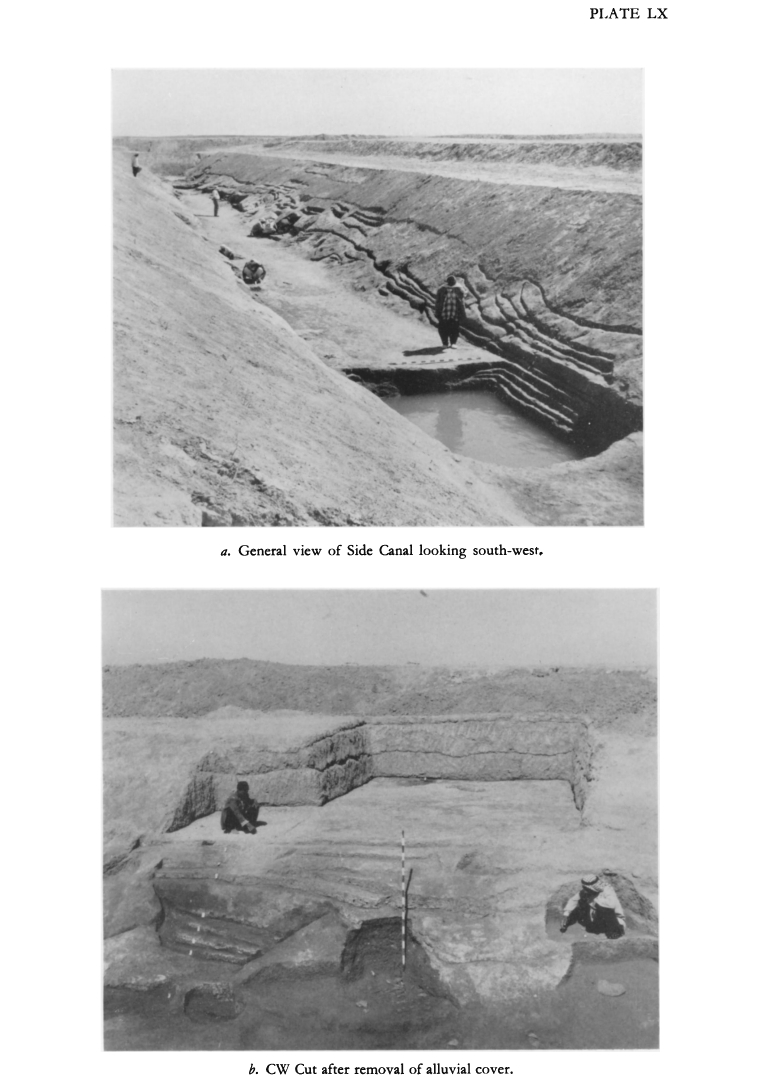 Excavations in the Side Canal: In the Side Canal itself we were able to distinguish four successive building levels (Plate LXI) together with at least one stratum of sherds below the lowest one. But due to the insubstantial character of the architecture as well as the lack of any evident change in the pottery the life [extent or time-period] of the individual levels would seem to have been relatively brief. In North Eastern Iraq the
Excavations in the Side Canal: In the Side Canal itself we were able to distinguish four successive building levels (Plate LXI) together with at least one stratum of sherds below the lowest one. But due to the insubstantial character of the architecture as well as the lack of any evident change in the pottery the life [extent or time-period] of the individual levels would seem to have been relatively brief. In North Eastern Iraq the 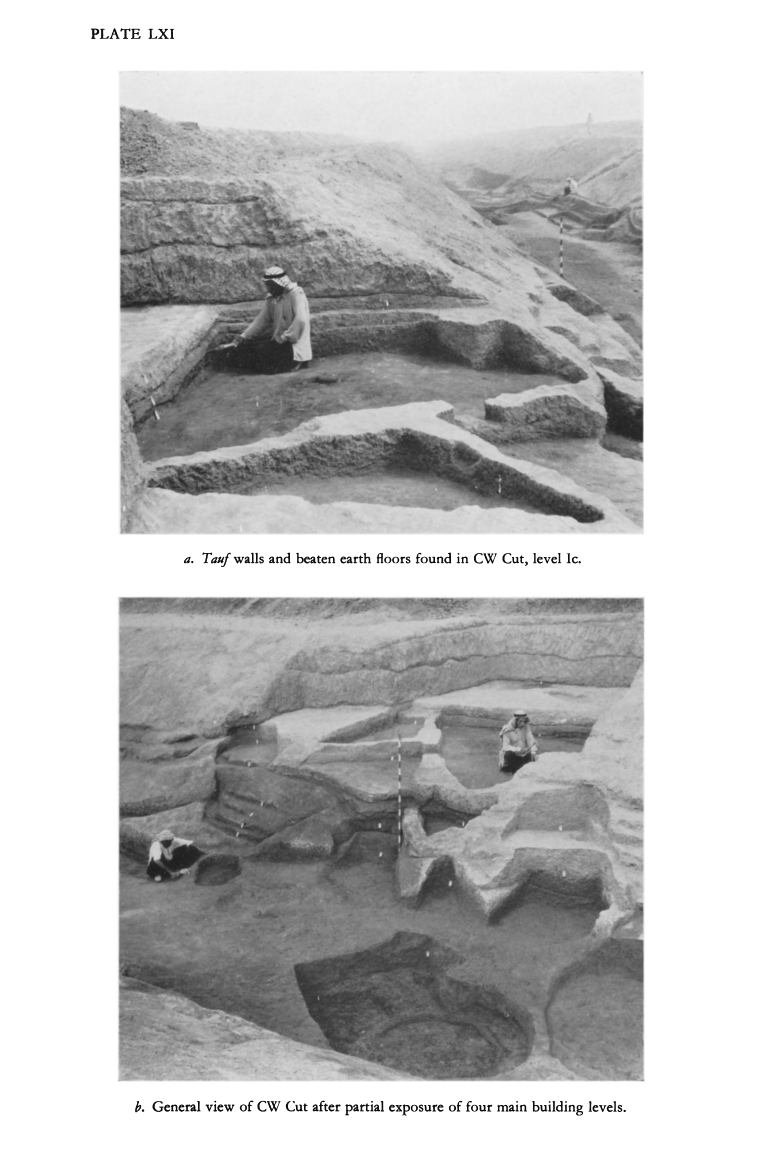 The uniform character of the whole settlement is reflected in its architecture as much as anything else. From the earliest to the latest levels tauf or pise walling prevails. Also the great majority of the buildings seem to have been
orientated in the same direction throughout the life of the settlement. The dwellings themselves all have a relatively primitive appearance with the individual rooms varying in shape from roughly rectangular structures to almost
circular or eliptical ones. Plastered wall faces would seem to have been relatively rare for only one or two fragments of fallen mud plaster were recovered in the course of the excavations.
The uniform character of the whole settlement is reflected in its architecture as much as anything else. From the earliest to the latest levels tauf or pise walling prevails. Also the great majority of the buildings seem to have been
orientated in the same direction throughout the life of the settlement. The dwellings themselves all have a relatively primitive appearance with the individual rooms varying in shape from roughly rectangular structures to almost
circular or eliptical ones. Plastered wall faces would seem to have been relatively rare for only one or two fragments of fallen mud plaster were recovered in the course of the excavations. 
